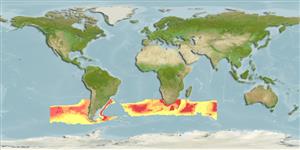Elasmobranchi (squali e razze) (sharks and rays) >
Squaliformes (Sleeper and dogfish sharks) >
Etmopteridae (Lantern sharks)
Etymology: Etmopterus: Greek, ethmos, -ou = sieve or ethmoides bone + Greek, pteron = wing, fin (Ref. 45335).
More on author: Günther.
Environment: milieu / climate zone / depth range / distribution range
Ecologia
marino; distribuzione batimetrica 220 - 1620 m (Ref. 44037), usually 400 - 600 m (Ref. 124555). Deep-water; 29°S - 59°S
Indian Ocean, Southern Pacific and Southern Atlantic (Ref. 106604). Reported from off the western Cape coast but the identity of South African specimens is questionable (Ref. 127434).
Length at first maturity / Size / Peso / Age
Maturity: Lm ? range ? - 75 cm
Max length : 86.0 cm TL maschio/sesso non determinato; (Ref. 122636); peso massimo pubblicato: 3.6 kg (Ref. 122636)
Short description
Chiavi di identificazione | Morfologia | Morfometria
Spine dorsali (totale) : 2; Spine anali: 0. A large, heavy-bodied lanternshark with a big head (Ref. 5578), bladelike unicuspidate teeth in lower jaw and teeth with cusps and cusplets in upper jaw, stocky body, conspicuous lines of denticles on body, conspicuous black markings on underside of body and tail, with tail marking short and not extending far posteriorly (Ref. 247). Dark brown or black in color, possibly darker below (Ref. 26346).
Found on outermost continental shelves and upper slopes (Ref. 247). Feeds on bony fishes including lanternfish, barracudina, synaphobranchid eels, oreo dories, hake, rattails, bathylagids, idiacanthids; also on squids (including histioteuthids and ommastrephids), octopuses, euphausiids, mysids, penaeid shrimp, salps, sponges and ribbonworms (Nemertina) (Ref. 124555). Bioluminescence observed, with the dorsal photophores, flank markings, and brighter pectoral fin and claspers are likely to be used for intraspecific communications and the ventrally emitted light is likely to be used for counterillumination (Ref. 123656). Ovoviviparous (Ref. 205), with 10-13 in a litter, size at birth about 18 cm (Ref. 6871) to possibly 30 cm (Ref. 124555), Minimum depth reported taken from Ref. 247.
Ovoviviparous, with 10-13 in a litter (Ref. 6871). Size at birth about 18 cm (Ref. 6871). Distinct pairing with embrace (Ref. 205).
Compagno, L.J.V., 1984. FAO Species Catalogue. Vol. 4. Sharks of the world. An annotated and illustrated catalogue of shark species known to date. Part 1 - Hexanchiformes to Lamniformes. FAO Fish. Synop. 125(4/1):1-249. Rome, FAO. (Ref. 247)
IUCN Red List Status (Ref. 130435)
Threat to humans
Harmless
Human uses
Pesca: di nessun interesse
Strumenti
Special reports
Download XML
Fonti Internet
Estimates based on models
Preferred temperature (Ref.
123201): 1.7 - 9.2, mean 3.2 °C (based on 174 cells).
Phylogenetic diversity index (Ref.
82804): PD
50 = 0.5000 [Uniqueness, from 0.5 = low to 2.0 = high].
Bayesian length-weight: a=0.00363 (0.00291 - 0.00454), b=3.08 (3.02 - 3.14), in cm total length, based on LWR estimates for this species (Ref.
93245).
Trophic level (Ref.
69278): 4.2 ±0.2 se; based on diet studies.
Resilienza (Ref.
120179): Basso, tempo minimo di raddoppiamento della popolazione 4.5 - 14 anni (Fec=10).
Fishing Vulnerability (Ref.
59153): Moderate to high vulnerability (54 of 100).
Climate Vulnerability (Ref.
125649): Low to moderate vulnerability (27 of 100).
Nutrients (Ref.
124155): Calcium = 7.13 [1.44, 36.37] mg/100g; Iron = 0.343 [0.085, 1.239] mg/100g; Protein = 19.4 [16.8, 21.5] %; Omega3 = 0.328 [0.118, 1.004] g/100g; Selenium = 12.4 [3.4, 39.9] μg/100g; VitaminA = 20.1 [4.0, 113.6] μg/100g; Zinc = 0.385 [0.186, 0.758] mg/100g (wet weight);
